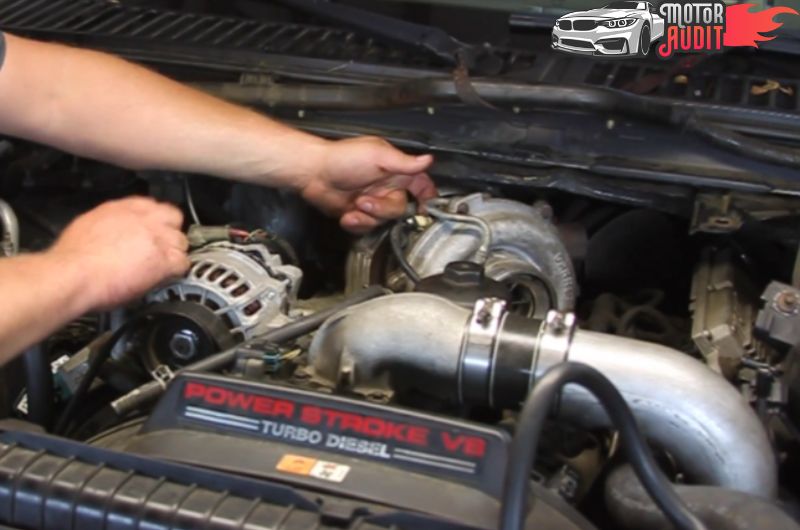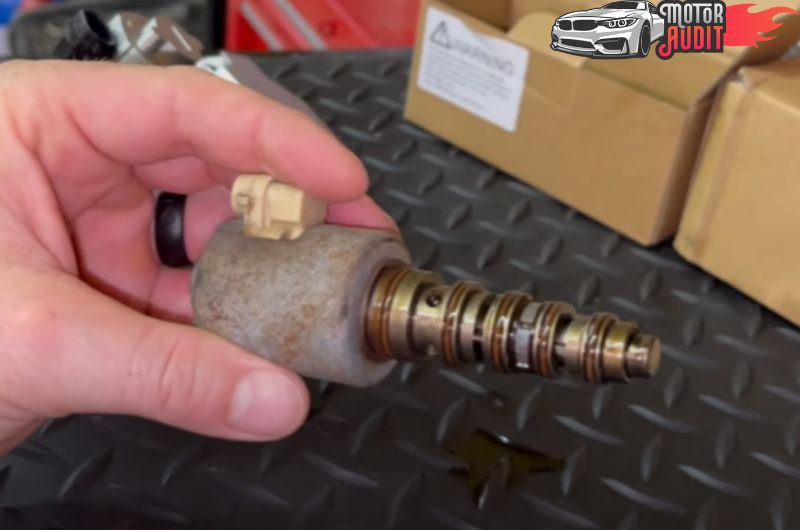What Is P0046 Code on 6.0L Powerstroke & How to Fix It?
The Ford 6.0 Powerstroke’s PCM generates many diagnostic error codes to let the user know about internal difficulties. The P0046 is one of these DTCs.
If you’re getting the error code & want to know it top to bottom, this article is for you. I’ve explained everything from symptoms to solutions in a beginner-friendly manner.
What Does the P0046 Code Mean on a 6.0L Powerstroke?
P0046 is one of the error codes of the Ford 6.0L Powerstroke. By definition, the P0046 code refers to Turbocharger Boost Control “A” Circuit Performance malfunction.
The turbocharger works as an air pump that pumps air to the engine & accelerates the engine’s power. Modern turbocharger-powered vehicles come with VGT (Variable Geometry Turbocharger) instead of a traditional turbocharger.
VGT operates through different adjustable vanes located outside of the turbine. The PCM controls these vanes to adjust pressure levels. However, the PCM does not control the traditional turbocharger but monitors them using a boost pressure sensor.
When the PCM (Powertrain Control Module) detects a problem with the boost control solenoid, it generates the DTC P0046.
Note: You may get the code scanned with an ordinary OBD-II Scanner but, you’ll need a bi-directional scanner for further information.
Symptoms Of Getting The P0046 Code on a 6.0L Powerstroke
The P0046 comes with several symptoms for you to identify the code. Here are some of the most common symptoms of the error code P0046:
- Check Engine Light (CEL) is Active
- Engine Temperatures Increases Dramatically
- Massive Amount Of Black Smoke From The Engine Exhaust
- Poor Acceleration Performance
- Other VGT Related Codes Such as – P0046, P0047, P0048, P0049, P004A Appearance
You shouldn’t see anything other than these symptoms if you’re getting the P0046 error code.
Read Also: What Are The Symptoms Of A 6.0 Powerstroke Turbo Failure?
The Causing Factors Of The Error Code P0046
Several factors can cause this diagnostic trouble code. Here are the most common causing factors of the DTC P0046:
- The Control Circuit Is Open or Shorted
- Faulty Wirings (Related to the Turbocharger)
- Faulty VGT Actuator
- Leaked Cat and Intercooler Pipes
- Faulty Powertrain Control Module
Besides these causing factors, faulty replacements can also bring this error code.
How Serious Is the P0046 Code On 6.0L Powerstroke?
It’s a very serious code for your 6.0L Powerstroke. Though this code won’t harm your engine immediately, it surely will in the future.
That’s why you should try to fix or solve this error code as soon as possible.
Read Also: 6.7L Powerstroke High Pressure Fuel Pump Failure Symptoms
How to Solve the P0046 Error Code On 6.0L Powerstroke?
Anybody with sound technical knowledge can fix the P0046 error code. If you want to solve this code on your own, make sure you have the following equipment mentioned below:
- Multimeter
- AutoEnginuity Scan Tool (or, Any Bi-Directional ScanTool)
- Technical Service Bulletin
Considering you’re ready with your equipment, let’s get started with the troubleshooting methods:
Check Wirings Related To The Turbocharger

Firstly, inspect your wirings coming from the turbocharger. Check if the wires are damaged or burnt. Also, check if any of your wire is loose/broken & touching the ground.
You can also check the wires by measuring resistance with the multimeter. If you find any irregularity with the wirings, replace them without delaying.
Check Cat and Intercooler Pipes
Having leaked cat (Catalytic Converter) & intercooler pipes can also cause boost failure. Follow these steps mentioned below to check if those pipes are okay:
- Step 1: Pull the whole air filter out
- Step 2: Start the truck & put your hand to block the pipe (From where you’ve detached the air filter)
- Step 3: Besides feeling heavy suction pressure, you should hear ‘weird’ noise coming from the cat & intercooler pipes.
If you hear a weird sound & see the airflow system is about to collapse, your Cat & Intercooler pipes are leakage-free. Otherwise, you have a leakage in either the cat pipe or the intercooler pipe.
Consider replacing both of those pipe systems & test if you’re still having a low boost problem while driving.
Check Variable Geometry Turbocharger Actuator

After checking wirings & pipes, it’s time for checking the VGT actuator. Follow the steps mentioned below to inspect your VGT actuator:
- Step 1: Turn off the key & disconnect the VGT Actuator
- Step 2: Turn on the key & engine should remain off
- Step 3: Connect the two pins (Pin 1 & Pin 2) of the actuator with a multimeter
- Step 4: Check if you have a voltage reading of more than 10.5.
What’s your voltage reading? If it’s more than 10.5V, your VGT actuator is good. If it’s less than that, you have a faulty VGT actuator that needs to be replaced.
Run Turbo Boost Test
Use your bi-directional scan tool to run a turbo boost test. I recommend using the AE (AutoEnginuity) Scantool as it gives more flexibility than others.
Go to your computer & run the turbo boost test setting the RPMs to 1200. Finally, follow along with the results (Scenario 1 & 2) mentioned below:
Scenario 1: RPM is Changing, But MGP & EBP are Not
With scenario 1, you’ll see a curve in the RPM graph & the MGP( Manifold Gauge Pressure) & EBP (Exhaust Gauge Pressure) graphs will be flat.
If you’re getting this result, you’re probably having two issues – a VGT/ Turbocharger issue or PCM issue.

To narrow down your problem, install a new PCM & see if you’re getting curves in three of the graphs while conducting a turbo boost test.
If you’re seeing everything is working fine, it was an issue with your PCM. If you’re getting the same result (Scenario 1) again, consider replacing your VGT & this problem will be solved.
Scenario 2: RPM isn’t Changing at All
If your RPM graph isn’t changing at all, even after conducting the turbo boost test – suspect to have faulty control solenoid & VGT.
Consider replacing your boost pressure solenoid first as it costs less. Later on, conduct the turbo boost test again & see if anything has changed. If not, replace the turbocharger & you’ll be fine.
Read Also: 7.3 Powerstroke High Pressure Oil Pump Or HPOP Symptoms?
How Much Does It Cost To Solve The P0046 Error Code?
The solving cost depends on the replacement parts you’re getting while fixing the error code P0046. For your clearer understanding, here is the price chart of the possible replacement parts:
- The PCM Costs Around $800
- VGT/Turbocharger Costs $700 to $2000
- Turbo Boost Pressure Solenoid Costs Around $100
- Cat Pipes Costs $60 to $70
- Intercooler Pipes Costs Around $350
- Wirings Can Cost Around $50
- AutoEnginuity ScanTool Costs $250 to $300
Besides the replacement parts cost, add an extra $75 to $150 per hour if you’re getting this work done via an auto shop.
Read Also: What Are The Symptoms Of A 6.7 Powerstroke Turbo Failure?
Common Mistakes While Solving The P0046 Code
You may make mistakes while fixing the code. Try avoiding these common mistakes mentioned below for extra caution:
- Not Getting A Bi-Directional Scan Tool & Replacing Parts Blindly
- Not Replacing The Cheaper Replacement Parts Before Hopping To The Costlier ones Like PCM & VGT
Also, don’t forget to check your TSB to know the exact location of your engine components mentioned in this article.
Read Also: What is P0470 Code On 6.0 & 7.3 Powerstroke & How To Fix?
Additional Comments To Consider Regarding The P0046 Code
It’s normal to get the error code P0046 if your vehicle has reached the 100k mileage. If so, simply remove the code using an OBD-II scan tool & you might (hopefully) completely get rid of the code.
Conclusion
I hope this article has served good value knowing the P0046 error code thoroughly. Now you know what & how to do to fix this code entirely.
If you’re a newbie & not comfortable tearing your engine component apart, consider getting expert help without thinking too much.




